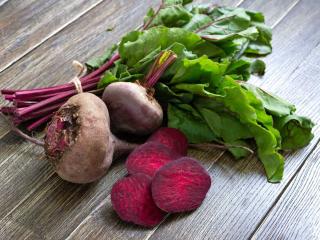

Egyptian red beet is an ancient, early variety, perfect for harvesting in summer.
Key ‘Flat of Egypt’ beetroot facts:
Latin name: Beta vulgaris
Common: Egyptian red beet, Crosby
Family: Chenopodiaceae
Type: root vegetable
Height: 12 to 16 inches (30 to 40 cm)
Planting distance: 8 inches (20 cm)
Exposure: sun-loving
Soil: fresh, light, deep, humus-rich
Planting: March → July – Harvesting: July → October.
It produces a medium-sized, smooth, flattened root with a deep purple-red color that’s visually stunning. You’ll find its flesh to be both tender and juicy with a rich, red color! The Egyptian red beet’s green leaves have burgundy veins that are magnificent.
This red beet variety rarely goes to seed. Easy to grow and very resilient, enjoy heirloom red beets of Egypt either raw or cooked, whatever tickles your fancy!
→ Note: there are three main sub-varieties: Flat of Egypt, Round of Egypt, and Crosby Egypt. They’re very similar in how to sow, grow, and care for them.

This beet variety loves fresh, light, deep soils rich in humus. But steer clear of rocky and limestone-packed soils.
If you’ve started your beets under shelter, transplant them when they display 5 leaves, no later.
→ Once the tiny plants sprout, usually within 7 days, thin them out to only keep a particularly vigorous plant every 8 inches (again, 20 cm).

Solid mulch on your soil will keep pesky weeds at bay, giving your beet room to thrive.
Looking for garden companions for your beet? Lettuce, kohlrabi, onion, and dwarf bean is the way to go.
While the ‘Flat of Egypt’, ‘Crosby’ and ‘Round of Egypt’ fend off all diseases in normal circumstances, sometimes rust and downy mildew can infect the patch.
And watch out for a tiny pest called the beet fly.


People often enjoy it raw in carpaccio or salad. But you can cook it too! For instance, try it sauté’ed or go for deep-frying!
If you boil it first, you can then bake it or even cook it under ash (wrapped in aluminum foil).
The young leaves of an Egypt red beet plant are fully edible. They’re packed with vitamins, minerals, and trace elements, they taste fabulous in mesclun or cooked spinach-style.